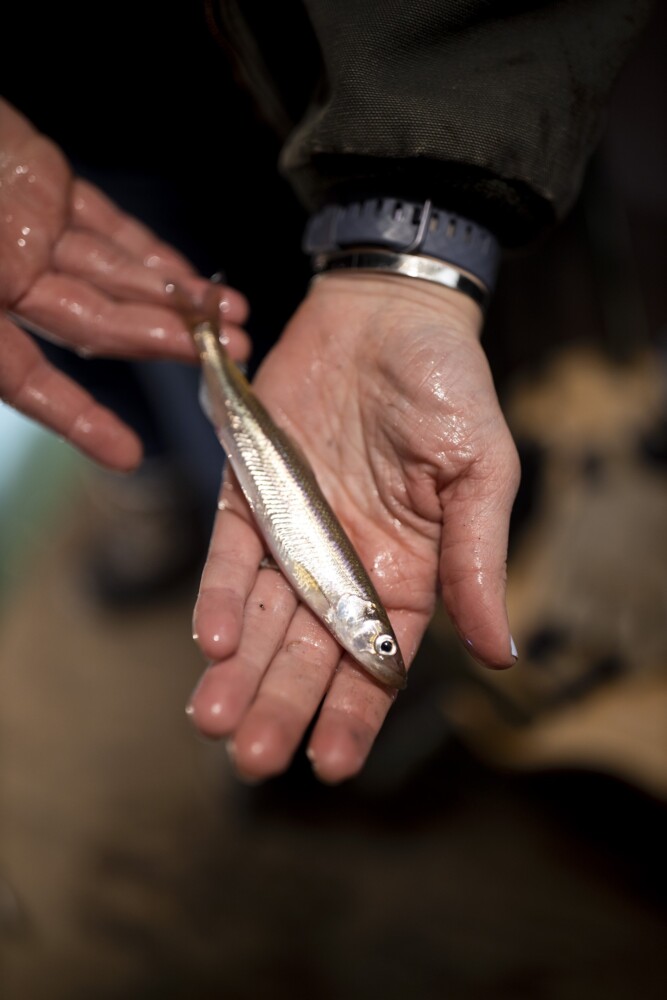The entire Maine coast once came alive with smelt runs as millions of silvery fish left the ocean each spring and raced up more than 300 rivers to spawn. The small, skinny, translucent fish were pursued by throngs of fishermen, both for recreational pleasure and commercial bait, the latter in such abundance it was sold and shipped to dealers in Boston.
But that was a century ago. In the past 30 years, the species’ range along the East Coast – once stretching from the Chesapeake Bay to Cobscook Bay – has declined so drastically that Maine’s Downeast coast is now the only place where rainbow smelt are found in good numbers.

Jeremy Cluchey, with The Nature Conservancy, pulls down line to fish for smelts at Leighton’s Smelt Camps on the Abagadasset River.
Smelt – with their unique protruding jaw – eat shrimp, worms and smaller fish. In turn, they are eaten by porpoises, seals, salmon, trout, striped bass, Atlantic cod and birds. If the smelt population crashes, many other species that rely on them for food also suffer.
Several factors have contributed to the smelts’ decline: Dams and culverts have blocked their passage up the rivers. And increased coastal development has caused pollution and sediment to leak into the streams and tributaries where smelt spawn.
Data collection
But much is unknown about Maine’s smelt population, and scientists say they need more information to better understand and manage the dwindling species. So this winter, a team of biologists from the Maine Department of Marine Resources, The Nature Conservancy, the Downeast Salmon Federation and the Gulf of Maine Research Institute is designing a study they hope will shed light on the state’s remaining rainbow smelt population.
The study, to be implemented in the spring of 2021, calls for dozens (ideally hundreds) of volunteers to conduct a survey of the spawning smelt and smelt eggs along the Maine coast. The biologists consider the volunteers key to compiling a body of data on the anadromous (or sea-run) fish. Such citizen science studies – in which non-scientists volunteer to gather field data – are powerful tools for scientists because acquiring so much data can otherwise be prohibitively expensive.
Data from the survey will be used to identify where improvements to spawning habitat can help the smelt population grow, state smelt biologist Mike Brown said.
The study marks the first time Department of Marine Resources will undertake a comprehensive statewide estimate of smelt numbers. In the past, according to Brown, biologists have looked at trend data in order to gauge the smelt population. The news there is not good: In the 1940s, the average Gulf of Maine commercial landings for smelt hovered at 600,000 pounds annually. That figure had dropped to 150,000 pounds by the 1960s and to less than 50,000 pounds in the 1980s. Harvest numbers today, Brown said, are even lower.
In 2014, the state updated regulations for the commercial and recreational smelt fisheries, an emergency action triggered by steep declines in Maine’s smelt population that “likely had been going on for several decades,” Brown said.
The new rules established the three smelt fishing zones along the coast. They also set bag limits for the first time for both the commercial and the recreational fisheries, except in Washington County, the last stronghold for rainbow smelt in the Northeast.
Today, Maine’s commercial fishery for smelt is centered far Downeast, Brown said, and is at its peak in April during the spring smelt spawning runs.
Shift east
A few rivers in southern Maine still have smelt runs. In the winter, businesses set up shacks on frozen rivers like the Kennebec and the Abagadasset, to cater to recreational fishermen from around New England who fish for smelt through the ice. But for the most part, Maine’s smelt fishing enthusiasm has shifted east.

Private smelt camps on the Abagadasset River. A few Southern Maine rivers still have recreational smelt fisheries, but most of the action has moved Downeast, as that’s the one area in Maine where the population numbers remain strong. Brianna Soukup/Staff Photographer
The abundant spring smelt runs Downeast still ignite the rich, century-old tradition of families coming to rivers in big groups to fish for smelt, then frying them up into tasty meals. In recent years, the Downeast Salmon Federation has taken advantage of such local interest, recruiting volunteers to help survey the smelt runs, said Sarah Madronal, a biologist with federation. Since 2014, she has recruited 50 volunteers to help locate spawning runs, and count the fish and their eggs. The federation survey is serving as the blueprint for the larger statewide survey.
“The communities are very tight-knit,” Madronal said. “It’s usually very easy to find people smelting. The Downeast coast is now the epicenter of spring smelt runs.”
The federation’s Downeast survey also asks volunteers what they know about smelt runs of the past. Madronal often joins local fishermen on Downeast rivers, and chats with old-timers she meets. Their stories alone are invaluable to science, she said, helping fill in gaps about where traditional smelt runs occurred.
“They may just be family stories,” Madronal said, “but hidden in that is a beautiful gem of historic data.”
Comments are not available on this story.
Send questions/comments to the editors.



